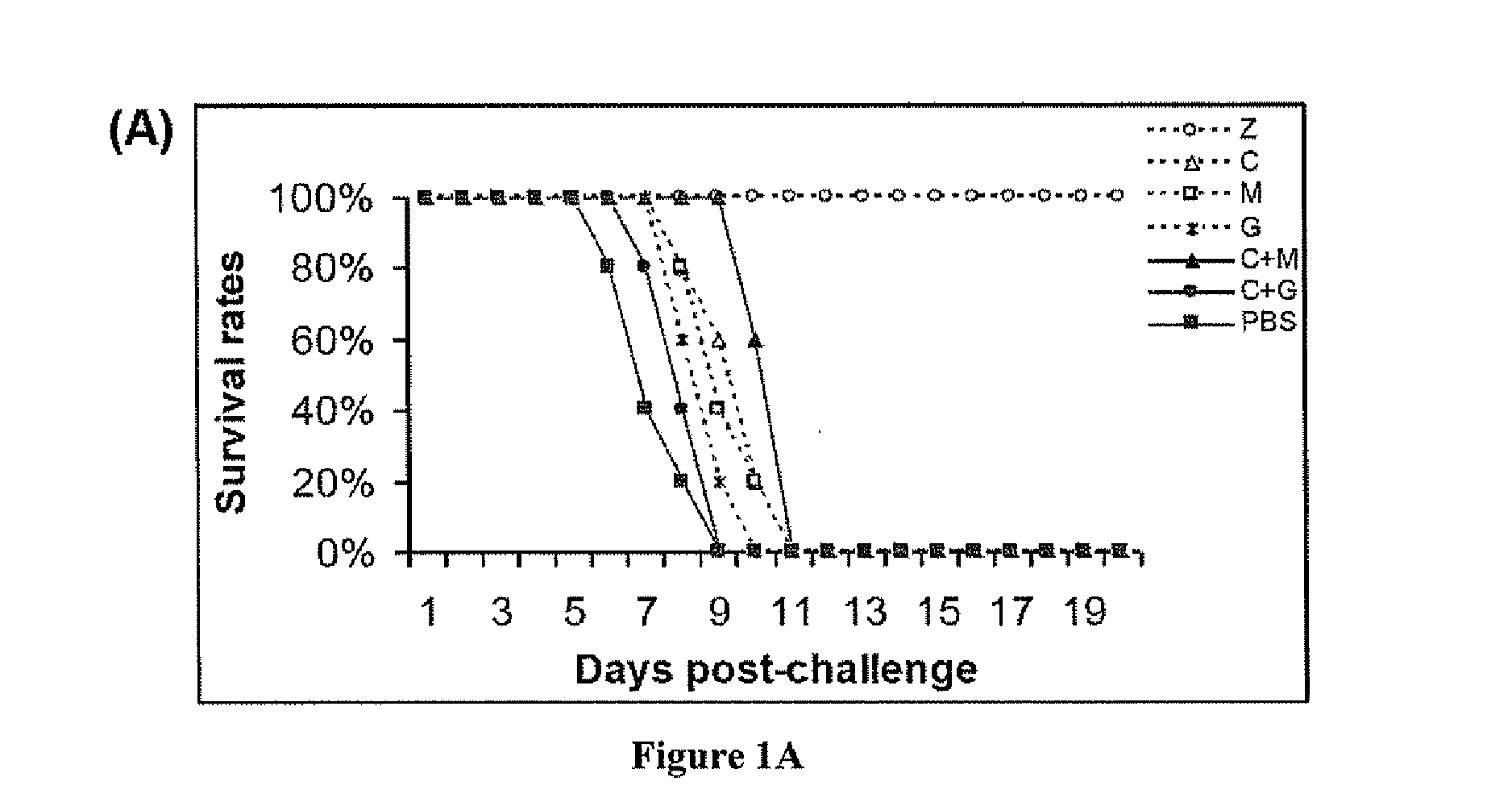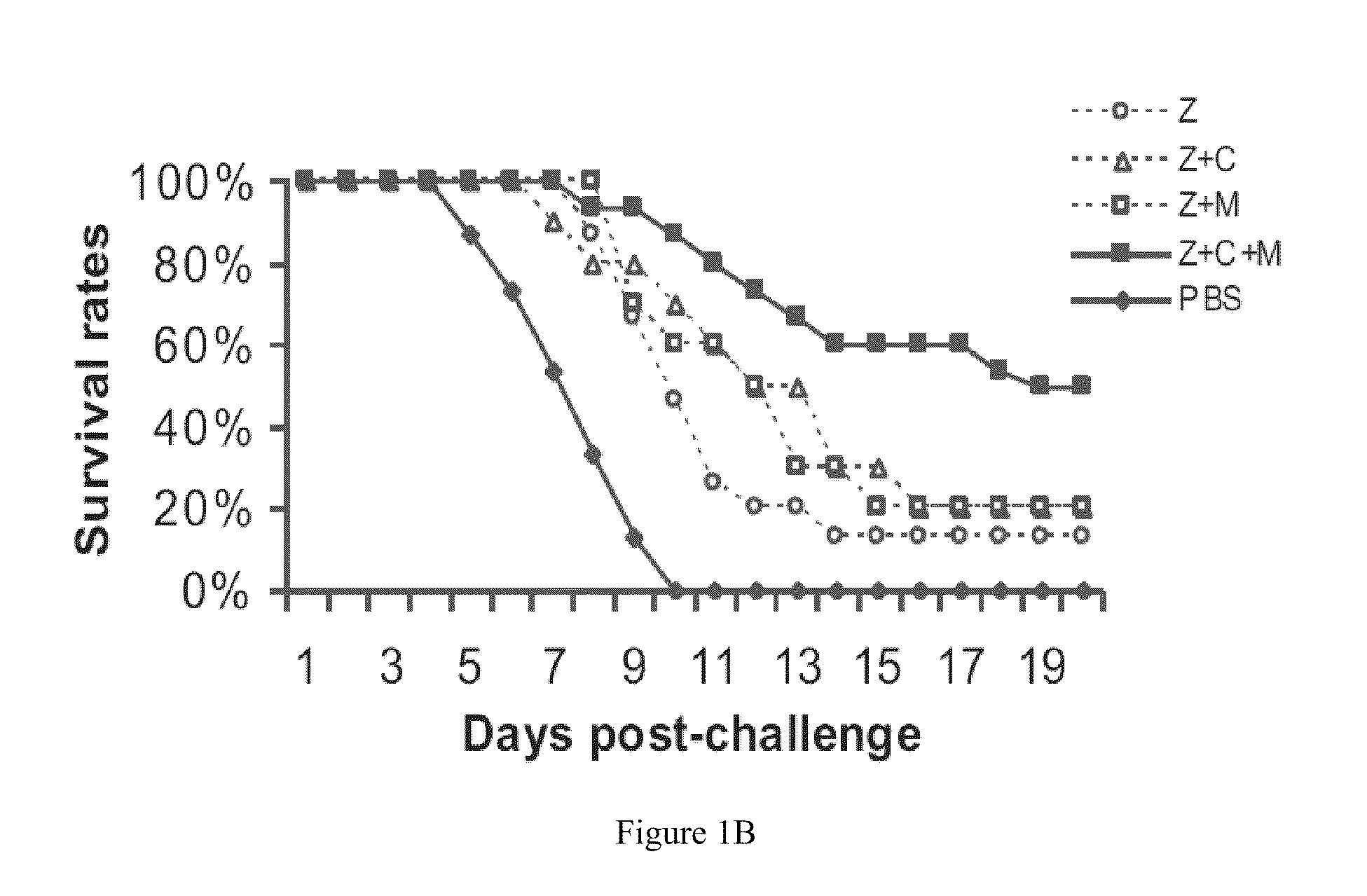Combination therapy for the treatment of influenza
- Summary
- Abstract
- Description
- Claims
- Application Information
AI Technical Summary
Benefits of technology
Problems solved by technology
Method used
Image
Examples
example 1
Treatment of Mice with Anti-Viral in Combination with Immunomodulators
[0068]Methods and Materials
[0069]Animal Model and Viral Challenge.
[0070]BALB / c female mice, 5 to 7 weeks old, were purchased from the Laboratory Animal Unit of the University of Hong Kong. Mice were kept in biosafety level 3 housing and given access to standard pellet feed and water ad libitum. Aliquots of stocks of influenza A virus strain A / Vietnam / 1194 / 04 were grown in embryonated eggs. Virus-containing allantoic fluid was harvested and stored in aliquots at −70° C. The 50% lethal dose (LD50) was determined in mice after serial dilution of the stock. One thousand LD50 was used for viral challenge in all the experiments. Influenza virus infection was established by intranasal inoculation of mice anesthetized by isoflurane.
[0071]Antiviral and Immunomodulatory Treatments.
[0072]Antiviral and immunomodulators were administered by the intraperitoneal (i.p.) route using 0.5 ml 29 gauge ultrafine needle insulin syringe...
example 2
Decrease in Viral Titers
[0080]Materials and Methods
[0081]Virological Tests.
[0082]Titers of released virus in tracheal-pulmonary lavage were determined by TCID50, while the intracellular viral RNA in lung tissues was quantified by real-time RT-PCR (Li, B. J., et al. Nat Med 11:944-951 (2005); Zheng, B. J., et al. Antivir Ther 10: 393-403 (2005); Wang, M., et al., Emerg Infect Dis 12:1773 1775 (2006)). Briefly, total RNA in lysed lung tissues was extracted using RNeasy Mini kit (Qiagen, Germany) and reverse transcribed to cDNA using applied SuperScript II Reverse Transcriptase™ (Invitrogen, USA). Viral NP gene and internal control-actin gene were measured by SYBR green Mx3000 Real-Time PCR System (Stratagene, USA), using primers NP-Forward: 5′-GAC CAG GAG TGG AGG AAA CA-3′ (SEQ ID NO:1), NP-Reverse: 5′-CGG CCA TAA TGG TCA CTC TT-3′ (SEQ ID NO:2); -Actin-Forward: 5′-CGT ACC ACT GGC ATC GTG AT-5′ (SEQ ID NO:3), -Actin-Reverse: 5′-GTG TTG GCG TAC AGG TCT TTG-3′ (SEQ ID NO:4).
[0083]ELISA....
example 3
[0089]Materials and Methods
[0090]Histopathological Analysis.
[0091]The lung, brain, spleen, kidney and liver tissues of challenged mice were immediately fixed in 10% buffered formalin and embedded in paraffin wax. Sections 4-6 μm in thickness were mounted on slides. Histopathological changes were examined by hematoxylin and eosin (H&E) staining under light microscope as described by Zheng, B. J., et al., Eur J Immun 32:3294-3304 (2002); Zheng, B. J., et al. Int J Cancer 92: 421-425 (2001).
[0092]Immunohistochemical Assay.
[0093]Lung sections were stained as described previously (28, 30) using an anti-influenza nucleoprotein monoclonal antibody (HB65, ATCC, USA) at 1:5000 dilution, goat anti-mouse IgG, H & L chain specific biotin conjugate (Calbiochem, USA) at 1:2000 dilution and streptavidin / peroxidase complex reagent (Vector Laboratories, USA).
[0094]Flow Cytometry.
[0095]Blood cells from the mice were stained with fluorescein-labelled monoclonal antibodies specific for mouse C...
PUM
| Property | Measurement | Unit |
|---|---|---|
| Time | aaaaa | aaaaa |
| Time | aaaaa | aaaaa |
| Time | aaaaa | aaaaa |
Abstract
Description
Claims
Application Information
 Login to View More
Login to View More - R&D
- Intellectual Property
- Life Sciences
- Materials
- Tech Scout
- Unparalleled Data Quality
- Higher Quality Content
- 60% Fewer Hallucinations
Browse by: Latest US Patents, China's latest patents, Technical Efficacy Thesaurus, Application Domain, Technology Topic, Popular Technical Reports.
© 2025 PatSnap. All rights reserved.Legal|Privacy policy|Modern Slavery Act Transparency Statement|Sitemap|About US| Contact US: help@patsnap.com



